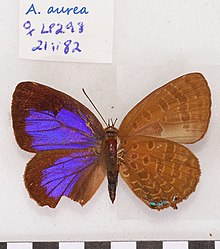| Arhopala aurea | |
|---|---|

| |
|
Scientific classification
| |
| Domain: | Eukaryota |
| Kingdom: | Animalia |
| Phylum: | Arthropoda |
| Class: | Insecta |
| Order: | Lepidoptera |
| Family: | Lycaenidae |
| Genus: | Arhopala |
| Species: | A. aurea
|
| Binomial name | |
| Arhopala aurea | |
| Synonyms | |
| |
Arhopala aurea is a species of butterfly belonging to the lycaenid family described by William Chapman Hewitson in 1862. [2] It is found in Southeast Asia (Peninsular Malaya, Singapore and Sumatra). [3]

Description
Male of a very bright greenish golden colour, on the hindwing with a sharply defined black marginal band extending to the centre of the wing, whereas the forewing only exhibits at the anal angle slight traces of the marginal black which attains a width of hardly 1 mm. The marking beneath deviates from the forms of eumolphus by the narrower, more regularly shaped postmedian band of both wings. [4]
References
- ^ Hewitson, 1862 Specimen of a Catalogue of Lycaenidae in the British Museum
- ^ "Arhopala Boisduval, 1832" at Markku Savela's Lepidoptera and Some Other Life Forms. Retrieved June 8, 2017.
- ^ Seitz, A., 1912-1927. Die Indo-Australien Tagfalter. Theclinae, Poritiinae, Hesperiidae. Grossschmetterlinge Erde 9: 799-1107, pls. 138-175
-
^ Seitz , A. Band 9: Abt. 2, Die exotischen Großschmetterlinge, Die indo-australischen Tagfalter, 1927, 1197 Seiten 177 Tafeln
 This article incorporates text from this source, which is in the
public domain.
This article incorporates text from this source, which is in the
public domain.
| Arhopala aurea | |
|---|---|

| |
|
Scientific classification
| |
| Domain: | Eukaryota |
| Kingdom: | Animalia |
| Phylum: | Arthropoda |
| Class: | Insecta |
| Order: | Lepidoptera |
| Family: | Lycaenidae |
| Genus: | Arhopala |
| Species: | A. aurea
|
| Binomial name | |
| Arhopala aurea | |
| Synonyms | |
| |
Arhopala aurea is a species of butterfly belonging to the lycaenid family described by William Chapman Hewitson in 1862. [2] It is found in Southeast Asia (Peninsular Malaya, Singapore and Sumatra). [3]

Description
Male of a very bright greenish golden colour, on the hindwing with a sharply defined black marginal band extending to the centre of the wing, whereas the forewing only exhibits at the anal angle slight traces of the marginal black which attains a width of hardly 1 mm. The marking beneath deviates from the forms of eumolphus by the narrower, more regularly shaped postmedian band of both wings. [4]
References
- ^ Hewitson, 1862 Specimen of a Catalogue of Lycaenidae in the British Museum
- ^ "Arhopala Boisduval, 1832" at Markku Savela's Lepidoptera and Some Other Life Forms. Retrieved June 8, 2017.
- ^ Seitz, A., 1912-1927. Die Indo-Australien Tagfalter. Theclinae, Poritiinae, Hesperiidae. Grossschmetterlinge Erde 9: 799-1107, pls. 138-175
-
^ Seitz , A. Band 9: Abt. 2, Die exotischen Großschmetterlinge, Die indo-australischen Tagfalter, 1927, 1197 Seiten 177 Tafeln
 This article incorporates text from this source, which is in the
public domain.
This article incorporates text from this source, which is in the
public domain.